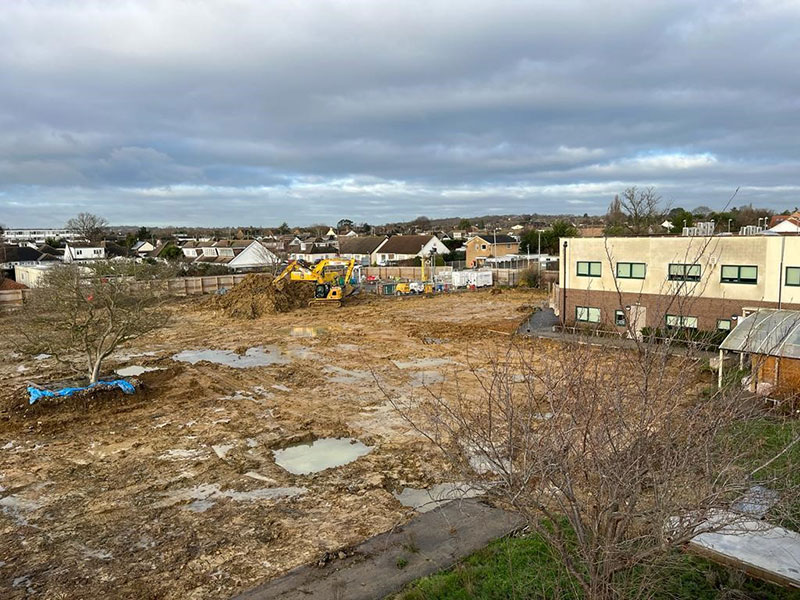What asbestos-contaminated land guidance is there?
It may be naturally occurring, but asbestos is not something that any human being should be exposed to; this fibrous silicate mineral can pose extreme dangers to health if breathed in or ingested.
Asbestos was used heavily across such industries as shipbuilding and construction for much of the 20th century, on the basis of such qualities as its strength and heat resistance. But as awareness grew of the link between asbestos exposure and the development of life-threatening diseases such as mesothelioma and asbestos-related lung cancer, its importation and use in the UK were finally banned in 1999.
Today, stringent regulations exist in the UK, to help ensure someone responsible for a building containing asbestos takes steps to carefully control the substance where it is still present. This, in turn, helps minimise the risk of future instances of asbestos exposure.
However, it is one matter when asbestos is contained within a building, and quite another thing when it is buried in soil on a brownfield site.
If there is land for which you are responsible, and where you suspect asbestos may be present, you might have consulted the various asbestos management guidance out there. In the process, though, you may have found that such guidance seemed to be aimed more at building owners, than developers or owners of land where there may be loose asbestos fibres or intact asbestos-containing products deep within the ground.
So, with all that in mind, is there any professional guidance out there for those individuals and organisations that are eager to ensure the responsible management of asbestos-contaminated land?
Below, our team at Oracle Solutions has set out the documents you need to be looking at.
What is asbestos-contaminated land?
The term “asbestos-contaminated land” refers to instances in which asbestos comes to be present in soil or land.
With asbestos having been used in so many products that were once widely used in construction in the UK, ranging from asbestos insulating board and asbestos cement products to roofing felt, rope seals, and gaskets, there are various ways in which these materials can end up in the ground.
These include:
- A substandard job having been done of removing asbestos from a building prior to the building being demolished, which may have led to asbestos-containing materials (ACMs) being present in the soil of made ground at the brownfield site
- Asbestos-containing products – such as below-ground asbestos lagged pipes and ducts – not having been removed at all prior to buildings being demolished
- Inadequate waste management processes having been used during historical manufacturing activity on the site
- Demolition rubble having been imported as a building material
- Waste materials having been illegally buried at the site
Many incidents like the above that may have led to the land becoming contaminated with asbestos, might have occurred many decades ago, when the UK did not have the strict rules and regulations for asbestos management, removal, and disposal that it has now.
Although some asbestos-containing products that end up in made ground soils or demolition rubble might be largely intact – and therefore relatively easy to spot with the naked eye – in some cases, such products might have broken up over time, and become mixed with other materials. In circumstances like the latter, any asbestos fragments will likely be much less visible.
The issue of asbestos-contaminated land can present a major safety concern, given that asbestos fibres contained within the ground could be highly vulnerable to accidental disturbance. This, in turn, could present the risk of someone nearby breathing in the material, without them even being aware of this, but with all the associated health risks.
Asbesto-contaminated land guidance: the essentials
There are various available sources of guidance on the topic of asbestos-contaminated land. If you are concerned about material on your land that you believe could be asbestos, you should consult the following for help and advice:
The Control of Asbestos Regulations 2012
This regulation, also referred to as “CAR 2012”, puts in place a “duty to manage” asbestos for those who manage non-domestic premises. The person or organisation that has this “duty” is the owner of the given non-domestic premises, or the entity that is clearly responsible for the maintenance and repair of the premises.
The “duty to manage” asbestos is set out in regulation 4 of CAR 2012, which outlines various requirements that dutyholders have. These include taking reasonable steps to determine whether there are ACMs in the given non-domestic premises – and if so, the location, amount, and condition of those materials – as well as assessing the risk of someone being exposed to asbestos fibres.
CAR 2012 also makes clear that dutyholders are expected to prepare a plan explaining in detail how risks arising from the ACMs will be managed. Furthermore, dutyholders will need to take the required steps to put that plan into action, alongside periodic reviewing and monitoring of the plan and the arrangements to act on it, to ensure the plan stays relevant and up to date.
The Health and Safety Executive (HSE)
The HSE is an agency of the UK Government with responsibility for encouraging, regulating, and enforcing workplace health, safety, and welfare. The agency provides information and advice to help dutyholders with their management and control of asbestos risks on their sites.
You will find various sources of information and guidance on the HSE website in relation to asbestos management, including the L143 Approved Code of Practice (ACOP) and guidance text for employers, on the subject of work that disturbs or is likely to disturb asbestos. It also covers asbestos sampling and laboratory analysis.
CL:AIRE
CL:AIRE stands for Contaminated Land: Applications in Real Environments. It is the name of a UK charity that develops and provides training resources, disseminates information, and serves as a go-to credible resource for all those looking to ensure the most sustainable possible reuse of land.
With support from the HSE, CL:AIRE has published an authoritative document, entitled “Interpretation for Managing and Working with Asbestos in Soil and Construction and Demolition Materials: Industry guidance”.
This guidance presents a definitive explanation of how the legal requirements of CAR 2012 have been interpreted to apply to work with soil, construction and demolition materials that are contaminated with asbestos.
Taken together, these sources of guidance and advice will enable you to fulfil your responsibilities with regard to the key principles of asbestos-contaminated land guidance:
- Risk assessment
- Planning and management
- Removal and disposal
- Monitoring and aftercare.
The steps involved in asbestos-contaminated land management
If you suspect that land or soil for which you are responsible could be contaminated with asbestos, undertaking the below processes will help you to manage the situation safely and effectively:
Site investigation and risk assessment
In line with the CAR 2012 requirements outlined above, you will need to confirm whether asbestos is present in the soil or land. If the material is indeed present, you will also need to know about the amount of this material, where in the ground it is embedded, and what type of asbestos is involved.
A full asbestos contamination land survey will enable you to answer all of these questions. But even before then, you should be undertaking a preliminary assessment of relevant information about the site, to help you determine whether the given land is likely to contain asbestos, and whether there is a likelihood of that land being disturbed.
There are other forms of testing that may be required, but much will depend on what your plans are for the site. So, we would advise you to contact our own asbestos professionals at Oracle Solutions for more specific advice.
The development of a management plan
With the site investigation and risk assessment having provided you with important information about any asbestos that may be present on your land, you will then need to use these details to guide you in putting together the management plan.
There are various steps that can be taken in relation to the management of asbestos on a given site, depending on such matters as the intended future use of the land, and the level of risk that the materials pose.
In some cases, efforts may be made to remove asbestos-contaminated material from the site. Alternatively, a decision may be made to leave the material in place and manage it to guard against the possibility of future disturbance and exposure.
The implementation of the management plan
As we referenced above, it is not enough to have an asbestos management plan; you must also put in place the arrangements that translate the plan’s contents from intentions into reality.
Again, the exact processes involved will depend on what you have set out in the plan as a response to the issue of asbestos contamination on your site. Nonetheless, it is crucial that whatever actions you take, they are legally compliant, economical, and effective at minimising asbestos risk.
Monitoring and review
Even if your response to the asbestos contamination of your land is to have contaminated materials entirely removed, there may still be scope for some asbestos to be left behind on the site.
And of course, if you decide to leave contaminated material in the ground, you will need to have arrangements in place to guard against the risk that such materials could present in the future.
As is the case with asbestos materials above ground, there is potential for such materials in the ground to deteriorate over time, which could range the extent and nature of the risk that they pose. Taking proactive steps to keep an eye on the material will therefore help ensure you make the most responsible decisions.
As CAR 2012 makes clear, there is also an expectation that dutyholders will periodically review and monitor the asbestos management plan itself, and the arrangements to act on it, in order to keep the plan relevant and up to date.
Ask our trusted experts to help you manage your asbestos-contaminated land
It isn’t always easy for property owners and developers to know where to look, when they are seeking sources of guidance on a matter as specialised as asbestos-contaminated land. And not all forms of that guidance will necessarily be geared towards the subject of asbestos-contaminated land specifically, so it is important to seek out both breadth and depth of resources.
Hopefully, the above will have helped set out to you the sources of guidance that will help you to properly and safely manage land where soils may be contaminated with asbestos.
To learn more about Oracle Solutions’ own hard-won knowhow and experience on the subject of asbestos-contaminated land, so that you can be sure of making the right decisions, please don’t hesitate to email us or to call the Oracle team today.

Written by Mark Carter
Mark Carter is a renowned expert in asbestos management, offering clients vital guidance on compliance and safety. His expertise is invaluable for navigating asbestos regulations, ensuring both safety and legal adherence. Mark's role is central in providing effective asbestos-related solutions, helping clients achieve their business objectives with an emphasis on regulatory compliance and safety in asbestos management.

